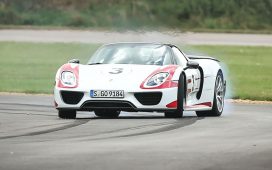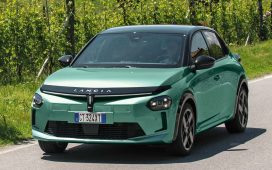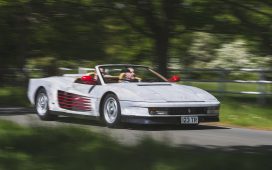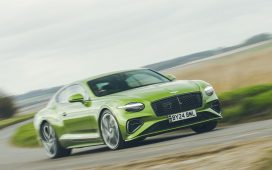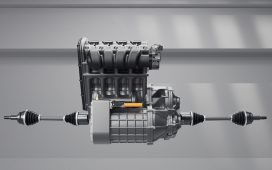A few weeks after the saloon was unveiled, the Mercedes E-Class Estate is ready to renew its rivalry with the upcoming all-new BMW 5 Series Touring and Audi A6 Avant.
Since the first E-Class generation arrived in 1984, Mercedes’ executive car has always been offered with a practical estate alternative – and the recently revealed W214 variant is no different.
With no estate version of the all-electric EQE equivalent, the E-Class Estate is still expected to account for up to 20 per cent of total E-Class sales.
The new Estate comes with a more rakish rear than the outgoing model, with a heavily sloped rear-pillar which product manager Felix Korn told us gives it a ‘shooting brake’ style. Korn also said this design influence doesn’t have any bearing on the future of the similarly sized CLS Shooting Brake.
Mercedes E-Class Estate: interior technology
Where the new E-Class Estate should really impress is the interior. The dashboard features the same ‘Superscreen’ as the saloon, with the latest MBUX infotainment. The optional screen is essentially a smaller version of the Hyperscreen found in the EQS and S-Class.
It offers a new layout which Mercedes says is more intuitive for front occupants. There are several new technologies such as the interior video camera and a ‘routine’ which learns habits of the driver to personalise the car’s features. New with the Superscreen is the ‘Just Talk’ function, which essentially replaces the need to say “Hey Mercedes” to operate the voice control, although to use it the driver has to be alone in the car.
As we’ve seen across the Mercedes range, the driver’s screen will show two different styles (Classic and Sport) and three modes: Navigation, Assistance and Service. To the rear there’s an optional electronically controlled tow bar, which can fold out at the touch of a button on the bootlid. The towing capacity for the E-Class is up to 2100kg with an 84kg weight on top of the bar, so e-bikes can be carried.
Mercedes E-Class Estate: practicality
The main reason you’d buy the Estate over the saloon is for the extra boot space, which varies depending on what’s under the bonnet. The E-Class Estate now has electrified engines throughout the range: the mild-hybrid versions come with 615 litres of boot space with the rear seats up – although that should be plenty for most families, it’s 25 litres down on the outgoing model because of the location of the battery beneath the boot floor.
The plug-in hybrid model has 460 litres of boot space, which is 20 litres less than the old PHEV. To help ensure the Estate remains stable, fully loaded or while towing, there’s air suspension on the rear axle as standard. All-round air suspension is an option.
Mercedes E-Class Estate: powertrains
In terms of engines, there are two mild hybrids – a petrol and a diesel – plus a plug-in hybrid petrol. All E-Class models get a nine-speed automatic transmission. The E 200 uses a 2.0-litre four-cylinder petrol engine that’s boosted by a 23bhp electric motor for a total of 201bhp. This allows the E 200 to sprint from 0-62mph in 7.8 seconds. The E 220d comes with a 2.0-litre four-cylinder diesel unit with the same mild-hybrid system for 194bhp and a 7.9-second 0-62mph time.
The range-topper for now will be the plug-in hybrid petrol E 300 e with a 2.0-litre four-cylinder engine mated to a 25.4kWh battery for 312bhp. The extra power means the PHEV will be the quickest from launch, taking 6.5 seconds to complete a 0-62mph sprint and with a top speed of 141mph. Mercedes claims the PHEV can travel up to 70 miles on electric power alone – a whopping 37 miles more than the old model. Felix Korn added that more plug-in hybrids are likely to be launched for the Estate – potentially a 300 d e diesel and a more powerful 400 e that has already been seen on the saloon.
The new mild-hybrid technology benefits in terms of efficiency with the petrol E 200 returning 42.1mpg on a combined cycle compared to 37.6mpg from the previous generation. The old E-Class Estate never came with the saloon’s petrol plug-in hybrid powertrain, although Mercedes’ scarcely believable 470.8mpg claim for the new E 300 e comfortably beats the old E 300 e saloon’s 176.6mpg figure.
Mercedes E-Class Estate: pricing and trim levels
The E-Class Estate will go on sale at the same time as the saloon this summer. Pricing hasn’t been announced, although we expect an increase on the outgoing model’s £50,835 starting point. Unlike Europe, which gets an entry-level Avantgarde model, the UK will get Exclusive and AMG Line variants.
We expect the Mercedes-AMG division to add its selection of 53 and 63-badged models, although it’s not clear yet what powertrains they’ll use.
Click here for our list of the best executive cars on sale right now…


